The Canon Digital IXUS 990 IS (also known as the PowerShot SD970 IS Digital Elph) is the new range-topping model in the extensive Digital IXUS / ELPH line-up of compact and stylish compact cameras. This 12 megapixel camera features a 5x, 37-185mm image-stablised lens, a large and high-resolution 3 inch LCD screen with 461,000 dots, DIGIC 4 image processor, Smart AUTO mode for beginners, plus Blink Detection and Face Detection technologies. In addition, the IXUS 990 IS can record 720p HD movies and has a built-in HDMI connector so that you can view photos and videos on an HDTV. The Canon Digital IXUS 990 IS / PowerShot SD970 IS Digital Elph is available in Classic Metallic for a recommended price of $379.99 / £379.00 / €449.00. Mark Goldstein took the Canon 990 IS all the way across the Pond to the USA to find out if this is the best IXUS / ELPH camera that money can buy.
Ease of Use
The Canon Digital IXUS 990 IS is a well-made, compact digital camera, with a stylish metal body and excellent overall finish. It's easily small enough to fit into the palm of your hand, despite featuring a 5x optical zoom lens that's equivalent to a focal length of 37-185mm. The maximum aperture is a fast f/3.2 at the wide end but a slow f/5.7 at the other extreme of the zoom range. The IXUS 990 IS is quite slim, measuring 2.6cms thick when turned off, making it suited to either a trouser pocket or small camera bag, and it weighs 160g without the battery or memory card fitted.
As with most Canon cameras that we've reviewed before, the IXUS 990 IS is one of the better models around in terms of build quality. Even the tripod mount is metal instead of plastic and positioned centrally in-line with the lens. The only minor criticism is the lack of any handgrip on the front, with just a smooth, flat finish embossed with the Canon logo, making it more difficult to hold than it really should be. Also, changing cards or batteries is not possible while the camera is mounted on a tripod, because the compartment door hinge is too close to the tripod socket.
The Canon Digital IXUS 990 IS has relatively few external controls, just 11 in total, which reflects the fact that this is quite a simple camera in functionality terms, with only limited photographic control on offer. All the controls are clearly labeled using industry-standard symbols and terminology. Compared to the previous IXUS 980 IS model, which offered a fully manual shooting mode, this represents a big change for the IXUS 990 IS, reverting to the more simplistic approach of most other IXUS cameras. It won't be a big deal for the less-experienced snapper, who will get more use out of the point-and-shoot Easy and new Smart Auto modes, but for many keen photographers looking for a second, pocket camera, this news will come as a bitter pill to swallow.
Located on top of the IXUS 990 IS are the Movie / Camera / Auto mode switch, On / Off button,, Zoom Lever and Shutter button, and on the bottom are the tripod mount and battery compartment, which also houses the SD memory card slot. On the rear of the IXUS 990 IS is the large 3 inch LCD screen, with a number of controls to the right. You can directly access the various focus and flash options by clicking left and right on the navigation pad, whilst up and down are respectively used to set the exposure compensation and timer options. There is sadly no dedicated button for ISO speed, which is a commonly used feature, although you can work around this by optionally setting the Print Transfer button to one of 7 available options (which include ISO speed).
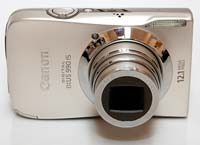 | 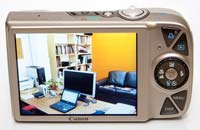 |
| Front | Rear |
Virtually all of Canon's compact digicams offer a few little known but advanced functions, and the flagship Digital IXUS / ELPH is no exception. These well-kept secrets, which you usually only learn about if you read the user guide attentively, include auto-focus lock (AFL), autoexposure lock (AEL) and flash exposure lock (FEL). To lock the focus on a subject for a series of consecutive shots, press the Left button on the four-way pad once while holding the shutter release depressed halfway. To lock the ambient exposure, do the same with the Up button. Flash exposure lock is achieved the same way when the flash is set to Forced On. AEL is available in Program, Quick Shot and Movie modes (you needn't hold down the shutter release for AEL when you are in Movie mode though). Sadly the manual focus (MF) mode and direct regulation of the flash's output which the IXUS 980 IS offered have not been retained for this camera.
The Function/Set button in the middle of the navigation pad opens a sub-menu, which allows you to set metering, colours, white balance, ISO speed, shooting mode, continuous shooting and image size/quality settings. This system is a good compromise given the size of the camera's LCD screen and therefore the limited space for external controls. Note that some of these options may be unavailable depending on which shooting mode you are in. A new addition is the clever little control wheel that encircles the four-way navigation pad, which allows you to quickly browse through your pictures and select the camera settings.
There are two ports on the right side of the Canon Digital IXUS 990 IS (when viewed from the back). The upper one is the new HDMI port, which allows you to connect the camera IS to a high-def TV set, but only if you purchase the optional HDMI mini-cable. The lower one accepts both the USB interface cable required to connect the IXUS 990 to a printer or computer, and the AV cable. There are no controls on the left side of the IXUS 990 IS.
Overall the camera body feels very well-designed and not at all cluttered, despite the presence of the large 3 inch LCD, which has a wide viewing angle from left to right, very welcome high resolution of 460,000 dots, and is visible in all but the brightest of sunlit conditions. There is no optical viewfinder on this model. If you have never used a digital camera before, or you're upgrading from a more basic model, reading the comprehensive and fairly easy-to-follow manual before you start is a good idea. Unfortunately Canon have chosen to cut costs and only supply the full manual as a PDF on a CD, rather than in printed format (there's just a short printed guide to the camera's basic features). Not much use if you're taking pictures and need to find out what a particular option does.
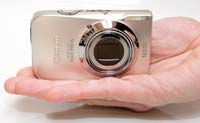 |  |
| Front | Main Menu |
The menu system on the Canon Digital IXUS 990 IS is extremely straight-forward to use and is accessed by a dedicated button underneath the navigation pad. Quite a lot of the camera's main settings, such as white balance, exposure compensation and ISO speed, are accessed elsewhere, so the main menu system isn't actually that complicated. A row of 2 icons along the top of the LCD screen represents the Camera and Setup sub-menus, with most of the options being the kind that you set once and then forget about. Due to the very large and bright LCD screen, the various options are easy to access and use, especially as only 6 are shown onscreen at one time. In the Shooting menu, you may do things like specifying the AF Frame (AiAF, Centre or Face Detect, the latter of which can now recognise faces at sharper angles), enabling or disabling Servo AF (useful for tracking subjects in motion), adjusting various flash settings, turning the live histogram on and off and setting the new i-Contrast function (which is Canon's answer to Sony's DRO, Nikon's D-lighting and Olympus' SAT, and works by lifting the shadows while leaving the midtones and the highlights alone in a high-contrast scene).
The Canon Digital IXUS 990 IS offers Program and a comprehensive range of different scene modes aimed at the user who just wants to point and shoot, making this camera particularly well-suited to the beginner. Zoom Blur is a useful new shooting mode that physically zooms the lens while the picture is taken, from the 37mm wide-angle setting to the 185mm telephoto focal length. The central part of the image remains sharp, whilst most of the outside is blurred giving a feeling of movement. The IXUS 990 IS also offers Smart Auto Mode. Similar to Panasonic's Intelligent Auto, Smart Auto Mode automatically determines the subject's brightness, contrast, distance and overall hue, then selects the best scene setting from 18 possible modes, which is more than most competitors. The IXUS 990 IS uncannily selected the right kind of scene mode for almost every environment that I tried it in. Strangely, Canon have dropped Easy Mode from the IXUS 990 IS, a useful mode for beginners which automatically sets every shooting option apart from turning the flash on and off.
The HD video capability of the IXUS 990 IS is one of the major features of this camera. It can record 720p video at 1280x720 pixels at 30fps in the Quicktime .MOV format. Unfortunately this format choice results in some massive file sizes that quickly fill up your memory cards. Sound quality is also not that great, with the usual background noise that accompanies movies shot with cameras that only have mono sound. Even worse, you can't use the optical zoom at all during movie recording, and there's no digital zoom setting either. Although the high-res footage is a nice addition, the IXUS 990 IS is certainly no replacement for a dedicated camcorder.
The IXUS 990 IS has a comprehensive Face Detection system that makes it easier to take great portraits. It detects up to 35 faces in a shot and adjusts the focus, exposure, flash settings and white balance automatically. The new Face Self Timer function is very useful for including yourself in group- or self-portraits. When you press the shutter release, walk into the scene, and two seconds after the camera detects that a new face appeared in the frame, the camera will automatically take the picture. Finally, Blink Detection can detect if a person in the picture has blinked and will automatically prompt you to retake the photo.
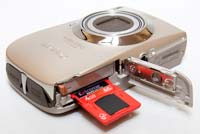 | 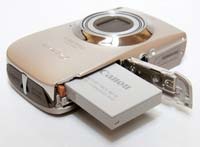 |
| Memory Card Slot | Battery Compartment |
The Canon Digital IXUS 990 IS features an anti-shake system, called IS Mode - turn it on in the menu system and the IXUS 990 IS automatically compensates for camera shake, which is a slight blurring of the image that typically occurs at slow shutter speeds. There are three different modes. Continuous is on all the time including image composition, Shooting is only on when you press the shutter button, and Panning as the name suggests is best when using the camera to track a moving subject. In practice I found that it does make a noticeable difference, as shown in the examples on the Image Quality page. You don't notice that the camera is actually doing anything different when anti-shake is turned on, just that you can use slower shutter speeds than normal and still take sharp photos.
Leaving the anti-shake system on all the time didn't affect the battery-life too much, with the camera managing just over 250 shots before the rechargeable Lithium-ion battery ran out of power. As part of a belt and braces approach, the anti-shake system is also backed up by motion detection technology that assesses camera or subject movement. The latter is effectively what rivals would refer to as digital anti-shake, as, activated in Smart Auto mode, it boosts ISO to a level (between ISO 80-800) it considers will compensate without hopefully introducing too much noise.
The start-up time from turning the Canon Digital IXUS 990 IS on to being ready to take a photo is quite quick at around 1.5 seconds, and it takes about 3 seconds to zoom from the widest focal length to the longest. Focusing is very quick in good light and the camera happily achieves focus indoors or in low-light situations, helped by a powerful focus-assist lamp. It takes about 0.5 second to store an image, allowing you to keep shooting as they are being recorded onto the memory card - there is a very quick LCD blackout between each image. In Continuous mode the camera takes just 1.0 frame per second at the highest image quality, which is slow for this class of camera, although the shooting rate is at least maintained until your memory card is full.
Once you have captured a photo, the Canon Digital IXUS 990 IS has a good range of options when it comes to playing, reviewing and managing your images. You can instantly scroll through the images that you have taken, view up to 36 thumbnails, zoom in and out up to 10x magnification, and filter images by date, category, folder and file type. You can also view slideshows, delete, protect, resize, trim and rotate an image, and set the print order and the transfer order. The Red-eye Correction options fixes red eye after you have taken a photo (useful if you forgot to activate it before) and i-Contrast improves the shadow/brightness areas, with Auto and Low, Medium and High settings (if you select i-Contrast before taking a photo, only Auto and Off settings are available). MyColors allows you to apply any of the 10 different effects on offer to a photo. The Display button toggles detailed settings information about each picture on and off, such as the ISO rating and white balance, and there is a small histogram available during playback which is helpful in evaluating the exposure. A third press of the Display button shows the image alongside a small, magnified section, useful for quickly checking the sharpness.
In summary the Canon Digital IXUS 990 IS is a stylish, compact and well-built point-and-shoot digital camera that is particularly well-suited to the beginner photographer.